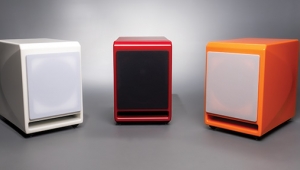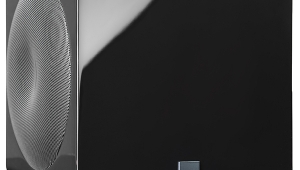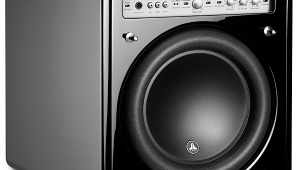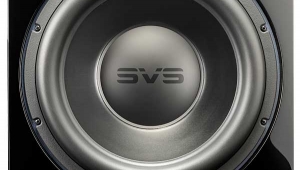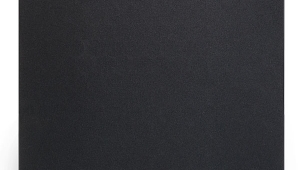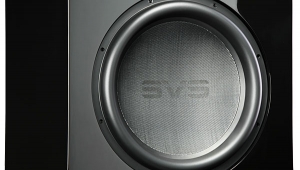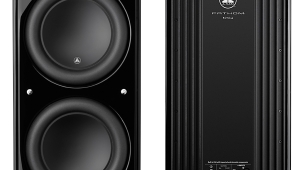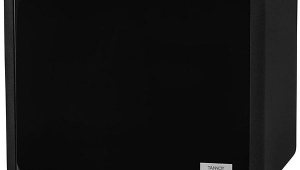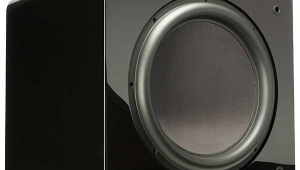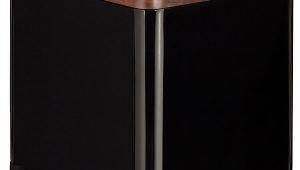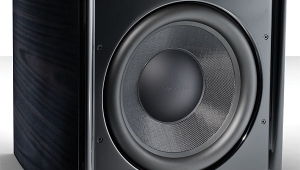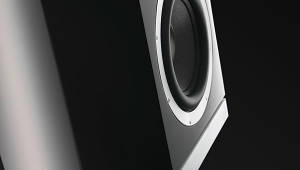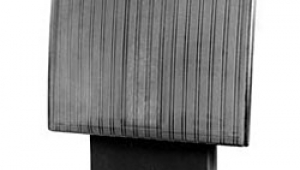| Columns Retired Columns & Blogs |
Revel Ultima Rhythm2 powered subwoofer
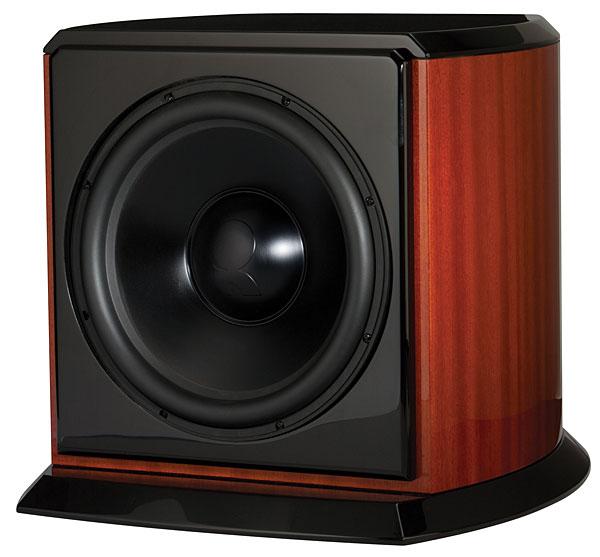
Powerful, massive, and expensive, Revel's Ultima Rhythm2 subwoofer ($10,000) swept me off my feet when I first saw it in Harman International's suite at the 2013 Consumer Electronics Show. It outsizes, by 49 lbs and 2.6 cubic feet, Revel's previous flagship model, the Ultima Sub30, which I reviewed in the November 2004 issue. Its specs read like no other sub's: 196 lbs; 18" cast-frame woofer; dual 4" voice-coils; 4kW peak power from twin internal amplifiers that generate 1kW RMS; 115dB peak acoustic output; a fully configurable, high-resolution, 10-band parametric equalizer (PEQ); an internal crossover with high- and low-pass outputs; and PC-based setup via USB. The Rhythm2's patent-pending design is said to let just enough air move in and out of the cabinet to prevent any distortion-inducing pressure due to heating of the voice-coils. And its veneer, shape, beveled top edges, and bottom plinth exude the quality found in Revel's top-of-the-line floorstanding speaker, the Ultima Salon2, with which I was familiar.
The Rhythm2's rear panel was devoid of the Sub30's myriad switches and tiny, hard-to-read labels. What remain are: a power switch just above the inlet for the AC cord; a three-position turn-on switch (Auto/On/Trigger); a gain dial; right- and left-channel inputs; high-pass outputs (XLR, RCA); a single output for driving other subwoofers; in and out jacks for a 12V trigger; and a USB port.
As an alternate to all those knobs and switches, the Rhythm2 is controlled by Revel's Low Frequency Optimization (LFO) software, installable in the buyer's computer. With the computer connected to the Rhythm2 via USB, LFO independently adjusts the sub's low- and high-pass crossover filter settings from 50 to 100Hz, in 1Hz increments; selects among six filter slopes (first-, second-, fourth-, or eighth-order, Butterworth or Linkwitz-Reilly); and delays the subwoofer's output (up to 631ms) to time-align it with the main speakers. LFO also manages the Rhythm2's PEQ to precisely adjust the main speakers' frequency response up to 300Hz, and "compensates for room-related regularities by applying a corresponding correction curve."
Setup
Revel shipped me one Ultima Rhythm2 and two Ultima Salon2s. A truck with a lift gate arrived with two pallets: 417 lbs of Salon2 on one, 243 lbs of Rhythm2 on the other. The handlers lugged the reinforced cartons into my house, up the short flight of stairs to my listening room, unpacked all three speakers, and placed them in the middle of the room.
They also left a small pile of materials near my listening chair: the Rhythm2's removable grille, detachable power cord, and 10-page quick-start guide. But where were the subwoofer optimization manual, the LFO software, and the CD-ROM full of test signals? It turns out that all manuals, test signals, target curves, and setup software can be downloaded from Revel's website, where they can be updated as often as needed.
I busied myself with placing and connecting the three Revels. Following the quick-start guide, I slid the sub into the room's right front corner, and the Salon2s into the spots usually occupied by my Quad ESL-989s. This put the Salon2s' inner edges 7' 6" apart, their outer edges 2' 10" from the sidewalls, and their front baffles 7' 2" from my ears when I sat down. The Rhythm2's front baffle was 4' behind the right-channel Salon2, and 9' 2" from my ears when seated. I listened to the Rhythm2 without its grille.
I ran a pair of balanced interconnects from the outputs of my Bryston BP26 preamplifier to the Rhythm2's inputs, and another pair from the Rhythm2's high-pass outputs to the inputs of a pair of Theta Digital Prometheus monoblocks (review to be published next month). Pure Silver Cable R50 double-ribbon speaker cables connected the amplifiers' speaker terminals to the Salon2s. I downloaded and installed Revel's pink-noise test tones, target response curves, and LFO software on my Lenovo X220 laptop, which runs Windows 7, and used a 6' USB cable from my printer to connect the computer to the Rhythm2. I started the LFO software, turned on the Rhythm2, and clicked the Connect button on the LFO main screen. The software's connection-status indicator turned green and identified the sub as "Rhythm2," telling me that LFO now controlled the sub. I then set the sub's output level to –19dB, as suggested by the LFO manual.
The Master's Calibration
Several days later, Kevin Voecks, Revel's New Product Development Manager, arrived to optimize its setup for my room. This involved matching the sub's frequency response to a series of proprietary target room-response curves that had been generated using JBL's Adaptive Room Correction and Optimization System (ARCOS). Voecks stated that these curves provide the "key to good room integration" for the Rhythm2, and allow LFO to "behave like 'ARCOS lite' in some respects."
To take his measurements for optimization, Voecks used my Studio Six iTestMic, a cost-effective, professional-grade test and measurement microphone that plugs directly into my iPhone 4's 30-pin connector, and which John Atkinson also recommends. The combo has proven precise enough to accurately measure, optimize, and match subwoofers to main speakers. Studio Six's Audio Tools app, available from iTunes, provides the Fast Fourier Transform (FFT) programming needed to compute and graph the mike's output.
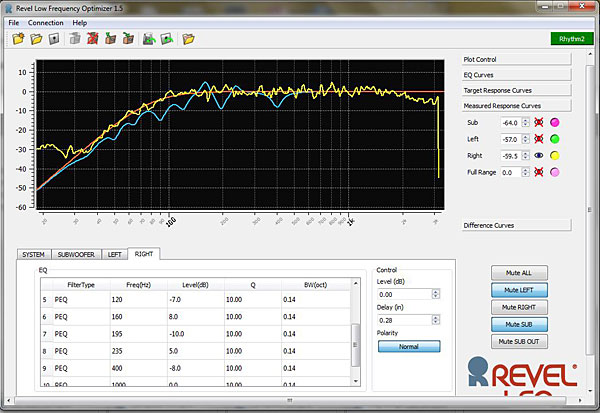
Fig.1 Revel LFO, display of target curve, equalizer inputs, and resulting FFT room-measurement curve for right-channel Revel Ultima Salon2 (range: +20dB to –30dB).

Fig.2 Revel LFO, display of target curve, equalizer input, and resulting FFT room-measurement curve for Revel Ultima Rhythm2 subwoofer (range: +20dB to –30dB).
Before taking any measurements, Voecks used the LFO software to set the Rhythm2's internal crossover filters to 80Hz for both the high- and low-pass filters, and their slopes to 24dB/octave, based on his previous experience designing and optimizing the sub's performance with the Salon2s. He also set the sub's infrasonic high-pass filter to Normal, which rolls off the Rhythm2's output below 20Hz. Because the sub's intrinsic equalization boosts its amplifier's drive as the audio signal's frequency descends, large but inaudible woofer excursions below 20Hz can drive the sub's twin amplifiers into clipping.
Voecks defeated the Rhythm2's output-level adjustment in favor of the more precise and more reliable settings available via LFO. He later discovered that the rear panel's manual output control shut off the sub when touched. He told me that, to fix this problem, the dealer would simply replace the rear panel and its electronics with a new assembly without having to ship the sub back to the factory.
Once he'd made all of the set-and-forget adjustments, Voecks played a digital file of uncorrelated pink noise (available from Revel's website) that he'd burned to a CD-R, and matched the output levels of the satellite speakers to the Rhythm2 using Audio Tools' SPL meter. Then he used the app's FFT module to measure each speaker's acoustic output for one minute at each of five different locations grouped around the top of my listening chair. These were then averaged, stored on my iPhone, and wirelessly imported to the LFO software.
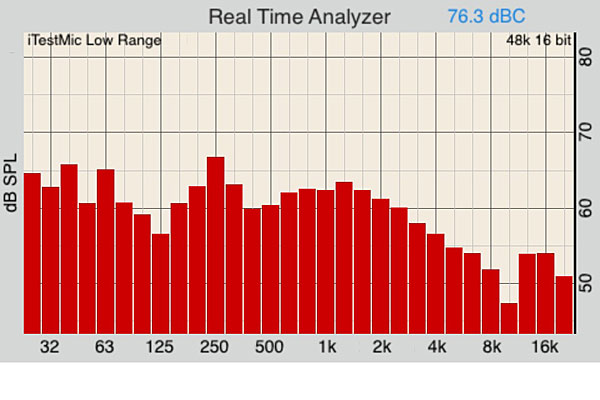
Fig.3 Revel Ultima Salon2s, full range, no subwoofer or equalization, 1?3-octave response in LG's listening room (5dB/vertical div.).

Fig.4 Revel Ultima Salon2s with Ultima Rhythm2 subwoofer, 1?3-octave response in LG's listening room (5dB/vertical div.).
Voecks then displayed the averaged FFT room-response data on my laptop in LFO, which showed the results from 10Hz to 4kHz. Using LFO's 10-band PEQ, he located the center frequencies of the room's nodes, reduced the levels at those frequencies, then fine-tuned the quality factors (Qs) of those reductions. Using the PEQ, he matched the resulting curves to predetermined target curves (fig.1), then adjusted the subwoofer's room response to better fit the specific target curve (fig.2).
When Voecks had gone, I checked the Salon2s' full-range room response with Audio Tools' Real Time Analysis (RTA) module by bypassing the subwoofer and its internal crossover. The RTA module is optimized for the range covered by subwoofers, and so is most accurate in the range of 20Hz–1kHz, above which the mike's response falls off. The Salon2s' low-frequency room response, when the floorstanders were run full range, showed a small peak at 250Hz, a dip at 125Hz, another peak at 63Hz, and a gentle rise below 40Hz (fig.3).
I reinserted in the signal path the Rhythm2 and its optimized crossover and PEQ settings, then repeated the room-response RTA measurements. The resulting graph was much flatter from 25Hz to 1kHz (fig.4).
Listening
Over the next two months, I listened to many recordings of singers, pipe organs, and film soundtracks. I began by reducing the Ultima Rhythm2's output by 2dB, to –21dB because I didn't want to lose the inherent bass power and extension of the Ultima Salon2s. These full-range speakers have produced some of the best deep-bass extension and heft I've heard in my room, and it was unclear to me what more the Rhythm2 could add.
- Log in or register to post comments
